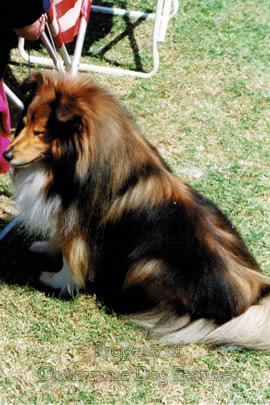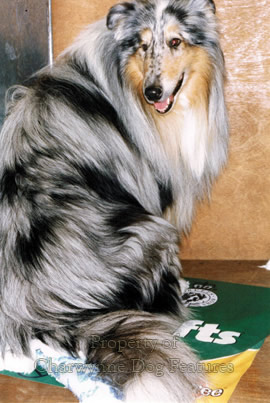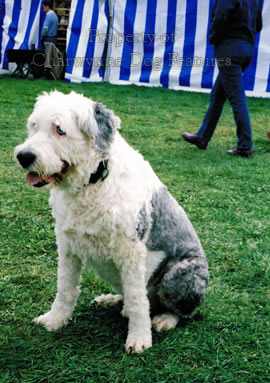859 COATING THE SHEEPDOG
COATING THE SHEEPDOG
by David Hancock
 False Values: Breeding for Glamour - the Over-Coat
False Values: Breeding for Glamour - the Over-Coat
“There have been three phases, or we might call them ‘epochs’, in Collie exhibiting. First came the workman epoch, when judges would only award prizes to fine working dogs; when good size, bone, legs and feet, quality and density of coat were a sine qua non, while masculine faces with intelligent expressions were looked for as the correct head properties. Then came the coat epoch, when judges went crazy over the Collie’s dress…Yet the craze of this epoch was not nearly so pernicious to the Collie’s welfare as is the infatuation of the present day. Judges and fanciers, with a few exceptions, now bow down and worship before the narrow head of a brainless idol.”
Trefoil, writing on Collies for the KC’s Review of the Year in The Kennel Gazette, January, 1892.
“…too often I found square Beardies covered in flowing coat and dipping in topline! One must not confuse glamour with quality – the two do not always go together.”
The judge of Bearded Collies at a Ch Show, 2012. 
Breeders go astray when they condone or actually seek exaggeration. Exaggeration is never good for dogs. And exaggerated coats are no exception. The last phrase in the above critique is a very clear instruction to a judge and can prevent such a breed becoming one of the 'coat-breeds', whereby every other part of the anatomy gets neglected but the part you can groom. It is interesting that the Bearded Collie's standard only uses the word long, in the section on coat, in connection with the dog's beard. The Briard's coat has to be at least 3" long. Surprisingly, the Old English Sheepdog's coat is not expected to be long in its standard. No longer does the Breed Standard of this breed state, as it did in 1926: “Too much coat is often worse than insufficient”. This breed would benefit if these words were restored.
Grooming Industry
Long coats in breeds of dog have created a mini-industry in two senses; firstly there is the provision of special tables, combs, brushes, shampoos, hair dryers, protective clothing and even top-knot ribbons, and, secondly there is the work undertaken by fanciers at home and at shows, whose industriousness never ceases to amaze me. I am all in favour of dogs being well groomed for the show ring, a dirty unkempt dog should never win. But are we getting to the stage where it's all getting out of hand? I don't mean the cost of it all, the time it all takes and the space it demands at crowded show venues, I mean the imposition on the dog both by way of the length and weight of coat and by making the dog stand for long periods being preened.
When dogs were valued for what they could do rather than what they looked like, excessively long coats did not feature to the degree they do now. If you look at the early show specimens of Bearded and Rough Collies and Shetland Sheepdogs, you will see jackets far shorter and less heavy than those on their counterparts today. Yet time and time again the pioneer breeders warned against this tendency. Mrs Willison, who launched the show career of the Beardie, was written to by James Garrow, the renowned sheepdog judge, and advised: "The coat should not be overlong and of a raw harsh texture. They should not require daily grooming...Have you drawn up the standard for the KC yet? You want to emphasise the rule on coat." 
Earlier this century, Henry Tilley, who contributed so much to the development of the Old English Sheepdog, wrote: "During recent years there has been an increasing tendency to over-development of the coat and especially for show purposes, but it is an adverse handicap for 'working' dogs which are exposed to all weathers, mud, and dusty roads." Is anyone out there listening to these wise old men? Once this strange obsessive lust for grooming rears its unwanted head, true type is soon replaced and then forgotten. The ultra-hirsute become the standard. The grooming addicts can then get to work but over the succeeding years so does public disinterest, unless a paint manufacturer needs a victim, sorry, emblem.
Writing in his Dogs and I of 1928, the knowledgeable and experienced Harding Cox, gave an interesting observation on Old English Sheepdog exhibitors: “I have a heartfelt pity for those exhibitors who have adopted the breed simply for show purposes. Theirs must be, indeed, a strenuous and anxious life! To keep a Show Bobtail’s coat in order wants a lot of care and cultivation. To see these dogs being ‘made up’ before entering the Ring is a side-show greatly to be recommended to those who are curious as to the ways and means of exhibitors.” One could ask the question: does ownership of the breed bring grooming challenges or do eager groomers knowingly seek out the breed in order to practise their art?
Breeding for Coat
William G Weager, reporting in The Kennel Gazette, March, 1888 on Old English Bobtail Sheepdogs at the Kennel Club Show in February of that year, stated: “There were two distinct types, the single-coated dog carrying feather and nearly clean faces, and the double or coat all over dog, i.e. dogs that have an equal length of coat from head to foot. The latter type I much prefer, and shall advocate for when the points are finally drawn up at the next meeting of the Old English Sheepdog Club, to be held at Warwick.” It is easy to see how pastoral dogs ‘dripping with coat’ came about.
Length and texture in a purebred dog's coat are part and parcel of the essential type of that breed. The 1995 Crufts judge in Briards wrote this in the critique: "While I am very aware of the school of thought that the Briard is a working animal and as such should not be overgroomed for the show ring, I have to admit that the spectacle of a full ring of well-groomed Briards, on the green carpet, was an impressive sight." If that kind of thinking prevails in this distinguished breed then within ten years the Briard will win the Afghan Hound classes! The Shetland Sheepdog should have an outer coat of long hair (but how long?). The Rough Collie is expected to have a coat that fits the outline of the dog's body (but doesn't!).
In the June 1891 edition of The Kennel Gazette, the Standard and Scale of Points for the breed as drawn up by DJ Thomson Gray, President of the Scottish Collie Club and acknowledged expert on Scottish dogs, was published as being adopted. Under General Appearance, the following words were used: “A lithe, active dog, with no useless timber about him, his deep chest showing strength, his sloping shoulders and well-bent hocks speed, and his ‘bawaint’ face high intelligence. As a whole, he should present an elegant and pleasing outline, quite distinct from any of our other domesticated breeds, and show great strength and activity.” Heavy-feathered legs were considered as a fault. In the KC official breed standard extant in 2012, the breed’s General Appearance had to be: “Appears as a dog of great beauty, standing with impassive dignity, with no part out of proportion to whole.” The strictures on leg coatings included ‘front legs well feathered, hind limbs above hocks profusely feathered.’ Of these two word pictures for the breed, which is more the likely to perpetuate a working dog with a manageable coat?
Length brings Penalties
When the Rough Collie was judged to a scale of points, easily the highest number (20 out of 100) was awarded for the coat. This appals me; how can the coat, especially in a working breed, possibly be the dog's most important feature? But it shows how the early exhibitors rated coat above all else. Is it at all surprising therefore that the Collie is susceptible to all the dermatoses that affect the modern dog? The excessively heavy coats of the Rough Collie and the Shetland Sheepdog were not there when these breeds first emerged and cannot be good for either breed. . The Rough Collie is required to have a coat that fits the outline of its body and is very abundant in the frill and mane, with profuse feathering above the hocks and a very profuse tail. I suspect that within my lifetime the Rough Collie's coat has doubled in length, which to me spoils the appearance of a distinctly handsome breed. The coat no longer fits the outline of the body, it drowns it. No dog could work with such a coat in the pastures. No shepherd would wish to own a dog with such a coat. For me this is a beautiful breed being slowly but surely ruined by its sheer weight of coat. No longer does the coat fit the outline of the body, as demanded by the breed blueprint; the physical beauty of this breed is in peril.
A correspondent called ‘Nestor’ writing The Annual Retrospect: The Breeds in 1892, Collies, published in The Kennel Gazette of January, 1893, gave the view that:
“There has been, in 1892, more than in any previous year, a strong predilection on the part of the more modern judges to award prizes to dogs possessing the longest heads, narrowest skulls, smallest ears, and longest coats, legs, feet, shoulders, chest, and, in fact make and shape generally being either ignored or looked upon as merely of secondary importance…density of coat, and not length, should be aimed at, for to a working dog in snow and slush a long coat is a terrible nuisance, as any practical Collie breeder well knows. True, to a show dog who is deficient in bodily properties, shelly in make, bad in shoulders, and with no quarters, a long coat is invaluable, like charity, covering a multitude of sins.”
The judge of Rough Collies at a 2013 Championship Show reported: “The Standard calls for a coat which fits the outline of the body but there were some Collies who had far too much coat, so much in fact that at times their eyes were buried in the coat and there was no indication of where the skull ended and the neck began. They are a working breed and would not be able to do the job they were intended to do if they were weighed down with excessive coat.” One hundred and twenty years later and the same fault is complained about; do the breed elders exert any influence for good in this breed? Or is it just a case of ‘we like them like that’ (so that’s good enough for the dogs too!)
Where will the passion for possessing dogs as grooming objects end? Are we really happy about producing breeds of dog whose coats are a physical handicap, almost a disablement? What is the point of valuing the origin of your breed and then breeding specimens of that breed with twice the coat of their ancestors? The key questions are surely these: What length of coat does a dog need to retain the type of that breed? and, what length of coat allows the dog to lead a healthy life? Seeing a working or sporting breed in bootees to keep its coat clean saddens me. It is important for us to show respect for our dogs, not just regard them as an accoutrement for a human hobby.